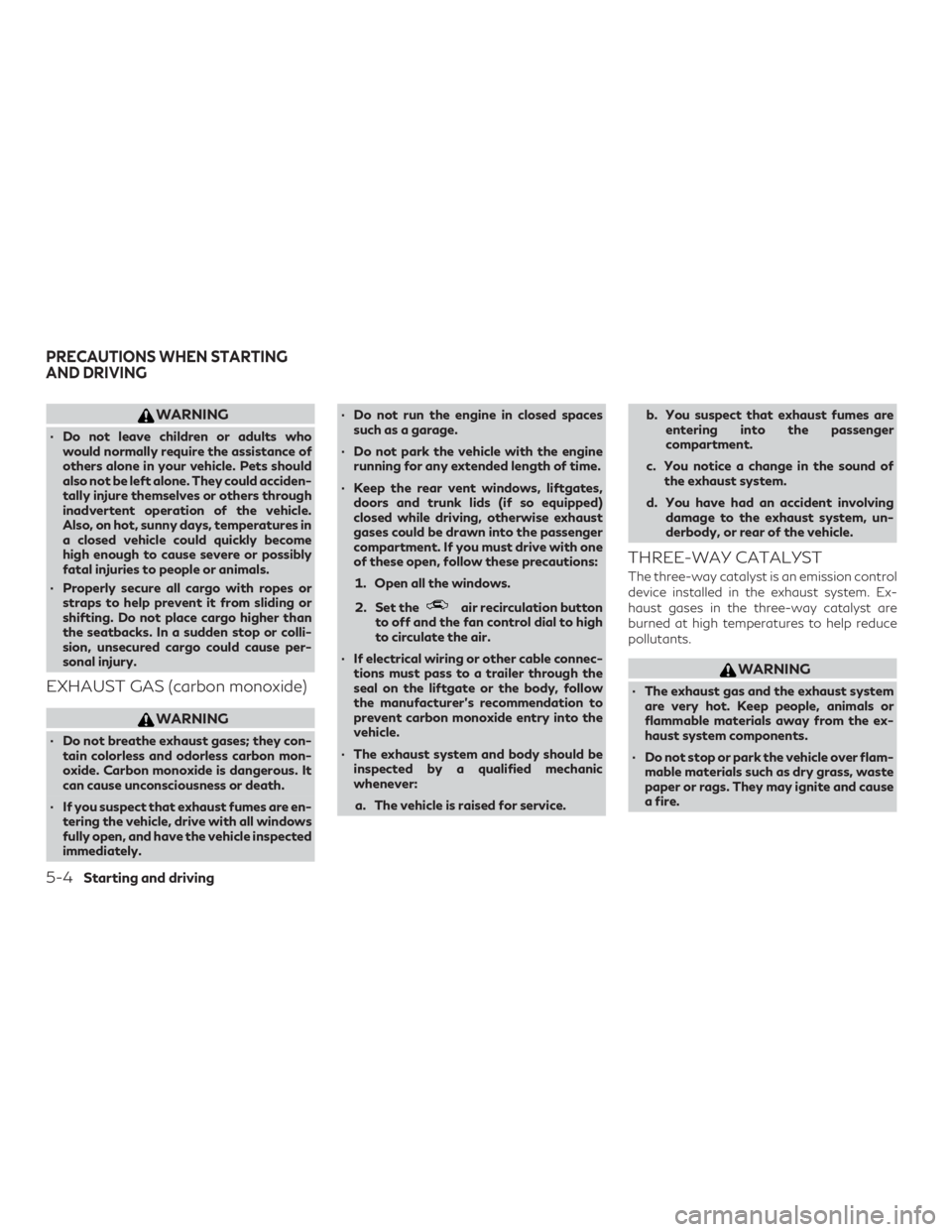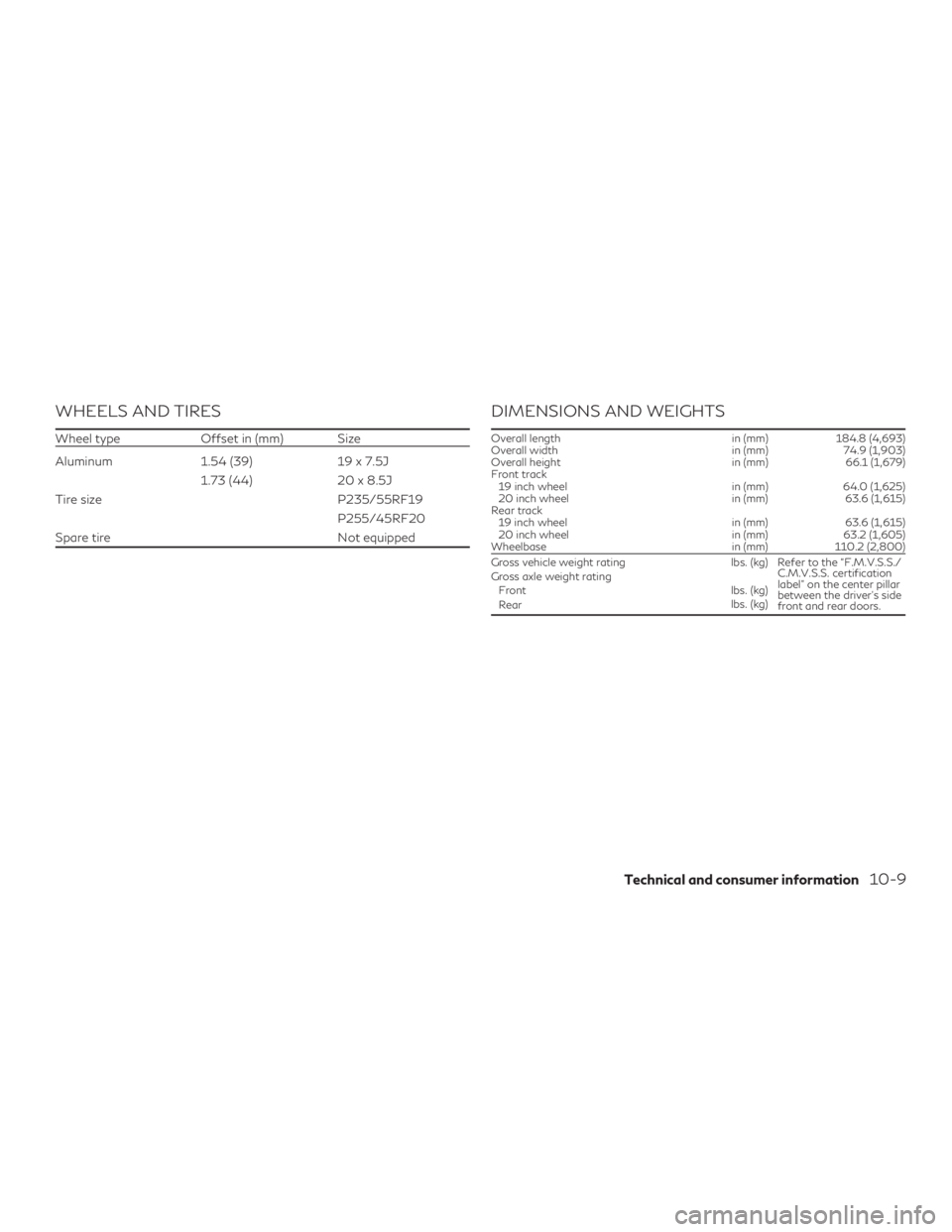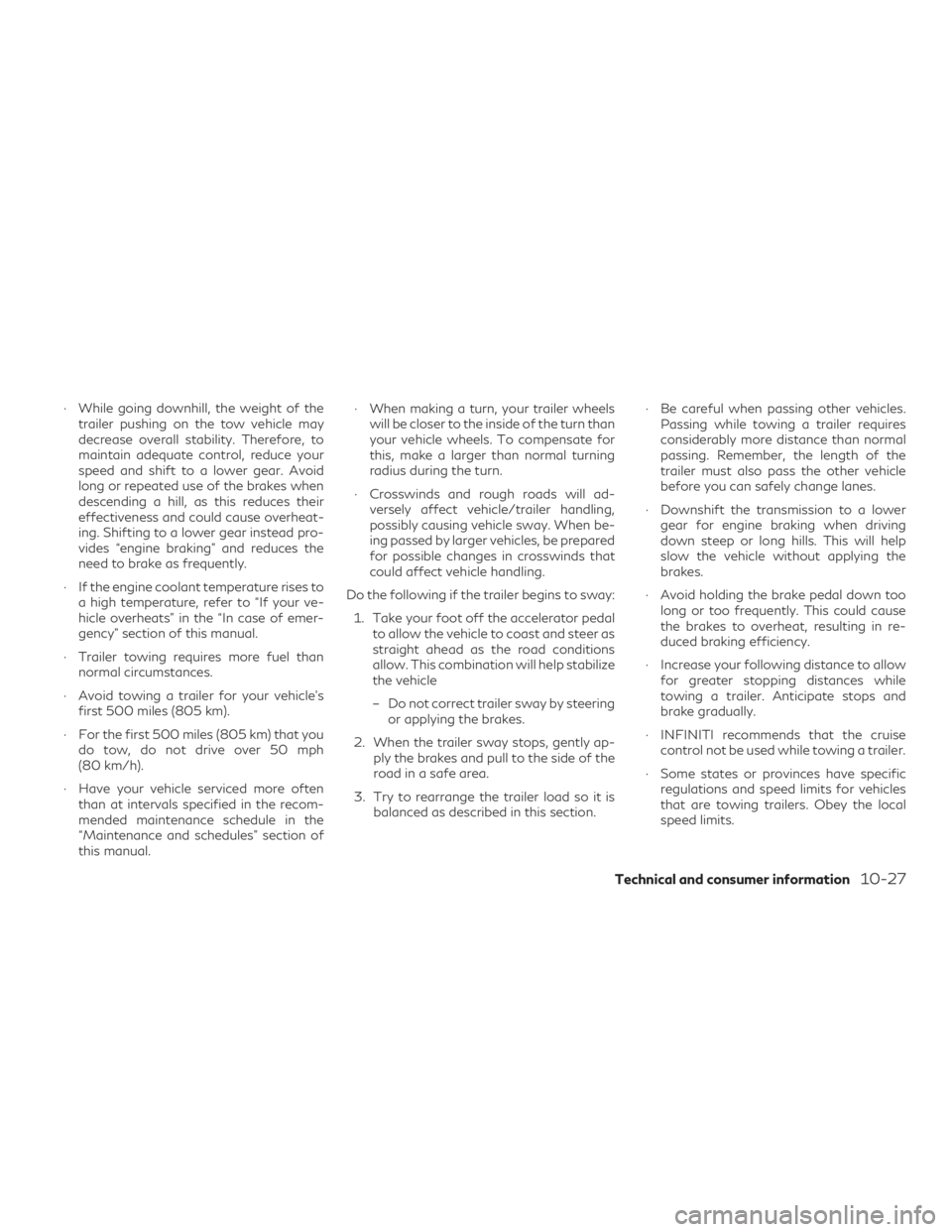length INFINITI QX50 2020 Owner's Manual
[x] Cancel search | Manufacturer: INFINITI, Model Year: 2020, Model line: QX50, Model: INFINITI QX50 2020Pages: 580, PDF Size: 7.43 MB
Page 45 of 580

Seat belt hook
When the seat belt is not in use and when
folding down the rear seats, hook the rear
seat belts on the seat belt hooks.
SEAT BELT EXTENDERS
If, because of body size or driving position, it
is not possible to properly fit the lap/shoulder
belt and fasten it, an extender that is compat-
ible with the installed seat belts is available
for purchase. The extender adds approxi-
mately 8 in (200 mm) of length and may be
used for all seating positions.Seat belt extenders are available for the:
∙ Driver and front passenger seating posi- tions
∙ Rear seating positions
It is recommended that you visit an INFINITI
retailer for assistance with purchasing an ex-
tender if an extender is required.
WARNING
∙ Only INFINITI seat belt extenders, made by the same company which made the
original equipment seat belts, should be
used with INFINITI seat belts.
∙ Adults and children who can use the stan- dard seat belt should not use an extender.
Such unnecessary use could result in seri-
ous personal injury in the event of an
accident.
∙ Never use seat belt extenders to install child restraints. If the child restraint is
not secured properly, the child could be
seriously injured or killed in a collision or a
sudden stop.
SEAT BELT MAINTENANCE
∙ To clean the seat belt webbing, apply a
mild soap solution or any solution recom-
mended for cleaning upholstery or car-
pet. Then wipe with a cloth and allow the
seat belts to dry in the shade. Do not
allow the seat belts to retract until they
are completely dry.
∙ If dirt builds up in the shoulder belt guide
of the seat belt anchors, the seat belts
may retract slowly. Wipe the shoulder
belt guide with a clean, dry cloth.
∙ Periodically check to see that the seat
belt and the metal components, such as
buckles, tongues, retractors, flexible
wires and anchors, work properly. If loose
parts, deterioration, cuts or other dam-
age on the webbing is found, the entire
seat belt assembly should be replaced.
LRS3035
Safety—Seats, seat belts and supplemental restraint system1-19
Page 266 of 580

WARNING
∙ Do not leave children or adults whowould normally require the assistance of
others alone in your vehicle. Pets should
also not be left alone. They could acciden-
tally injure themselves or others through
inadvertent operation of the vehicle.
Also, on hot, sunny days, temperatures in
a closed vehicle could quickly become
high enough to cause severe or possibly
fatal injuries to people or animals.
∙ Properly secure all cargo with ropes or straps to help prevent it from sliding or
shifting. Do not place cargo higher than
the seatbacks. In a sudden stop or colli-
sion, unsecured cargo could cause per-
sonal injury.
EXHAUST GAS (carbon monoxide)
WARNING
∙ Do not breathe exhaust gases; they con-tain colorless and odorless carbon mon-
oxide. Carbon monoxide is dangerous. It
can cause unconsciousness or death.
∙ If you suspect that exhaust fumes are en- tering the vehicle, drive with all windows
fully open, and have the vehicle inspected
immediately. ∙ Do not run the engine in closed spaces
such as a garage.
∙ Do not park the vehicle with the engine running for any extended length of time.
∙ Keep the rear vent windows, liftgates, doors and trunk lids (if so equipped)
closed while driving, otherwise exhaust
gases could be drawn into the passenger
compartment. If you must drive with one
of these open, follow these precautions:
1. Open all the windows.
2. Set the
air recirculation button
to off and the fan control dial to high
to circulate the air.
∙ If electrical wiring or other cable connec- tions must pass to a trailer through the
seal on the liftgate or the body, follow
the manufacturer’s recommendation to
prevent carbon monoxide entry into the
vehicle.
∙ The exhaust system and body should be inspected by a qualified mechanic
whenever:
a. The vehicle is raised for service. b. You suspect that exhaust fumes are
entering into the passenger
compartment.
c. You notice a change in the sound of the exhaust system.
d. You have had an accident involving damage to the exhaust system, un-
derbody, or rear of the vehicle.
THREE-WAY CATALYST
The three-way catalyst is an emission control
device installed in the exhaust system. Ex-
haust gases in the three-way catalyst are
burned at high temperatures to help reduce
pollutants.
WARNING
∙ The exhaust gas and the exhaust systemare very hot. Keep people, animals or
flammable materials away from the ex-
haust system components.
∙ Do not stop or park the vehicle over flam- mable materials such as dry grass, waste
paper or rags. They may ignite and cause
a fire.
PRECAUTIONS WHEN STARTING
AND DRIVING
5-4Starting and driving
Page 539 of 580

WHEELS AND TIRES
Wheel typeOffset in (mm) Size
Aluminum 1.54 (39)19 x 7.5J
1.73 (44) 20 x 8.5J
Tire size P235/55RF19
P255/45RF20
Spare tire Not equipped
DIMENSIONS AND WEIGHTS
Overall lengthin (mm)184.8 (4,693)
Overall width in (mm)74.9 (1,903)
Overall height in (mm)66.1 (1,679)
Front track 19 inch wheel in (mm)64.0 (1,625)
20 inch wheel in (mm)63.6 (1,615)
Rear track 19 inch wheel in (mm)63.6 (1,615)
20 inch wheel in (mm)63.2 (1,605)
Wheelbase in (mm)110.2 (2,800)
Gross vehicle weight rating lbs. (kg) Refer to the “F.M.V.S.S./
C.M.V.S.S. certification
label” on the center pillar
between the driver’s side
front and rear doors.
Gross axle weight rating
Front lbs. (kg)
Rear lbs. (kg)
Technical and consumer information10-9
Page 557 of 580

∙ While going downhill, the weight of thetrailer pushing on the tow vehicle may
decrease overall stability. Therefore, to
maintain adequate control, reduce your
speed and shift to a lower gear. Avoid
long or repeated use of the brakes when
descending a hill, as this reduces their
effectiveness and could cause overheat-
ing. Shifting to a lower gear instead pro-
vides “engine braking” and reduces the
need to brake as frequently.
∙ If the engine coolant temperature rises to a high temperature, refer to “If your ve-
hicle overheats” in the “In case of emer-
gency” section of this manual.
∙ Trailer towing requires more fuel than normal circumstances.
∙ Avoid towing a trailer for your vehicle’s first 500 miles (805 km).
∙ For the first 500 miles (805 km) that you do tow, do not drive over 50 mph
(80 km/h).
∙ Have your vehicle serviced more often than at intervals specified in the recom-
mended maintenance schedule in the
“Maintenance and schedules” section of
this manual. ∙ When making a turn, your trailer wheels
will be closer to the inside of the turn than
your vehicle wheels. To compensate for
this, make a larger than normal turning
radius during the turn.
∙ Crosswinds and rough roads will ad- versely affect vehicle/trailer handling,
possibly causing vehicle sway. When be-
ing passed by larger vehicles, be prepared
for possible changes in crosswinds that
could affect vehicle handling.
Do the following if the trailer begins to sway: 1. Take your foot off the accelerator pedal to allow the vehicle to coast and steer as
straight ahead as the road conditions
allow. This combination will help stabilize
the vehicle
– Do not correct trailer sway by steering or applying the brakes.
2. When the trailer sway stops, gently ap- ply the brakes and pull to the side of the
road in a safe area.
3. Try to rearrange the trailer load so it is balanced as described in this section. ∙ Be careful when passing other vehicles.
Passing while towing a trailer requires
considerably more distance than normal
passing. Remember, the length of the
trailer must also pass the other vehicle
before you can safely change lanes.
∙ Downshift the transmission to a lower gear for engine braking when driving
down steep or long hills. This will help
slow the vehicle without applying the
brakes.
∙ Avoid holding the brake pedal down too long or too frequently. This could cause
the brakes to overheat, resulting in re-
duced braking efficiency.
∙ Increase your following distance to allow for greater stopping distances while
towing a trailer. Anticipate stops and
brake gradually.
∙ INFINITI recommends that the cruise control not be used while towing a trailer.
∙ Some states or provinces have specific regulations and speed limits for vehicles
that are towing trailers. Obey the local
speed limits.
Technical and consumer information10-27